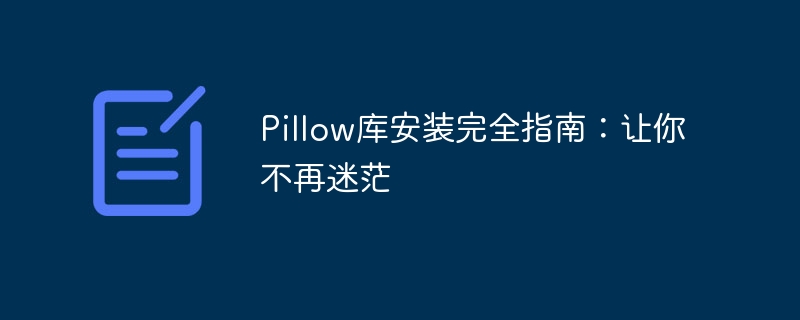

Pillow library is a powerful Python image processing library. It provides a wealth of image processing functions, including image reading, modification, saving, as well as image filtering, transformation and Merge etc. Before using the Pillow library, we need to install and configure it first. This article will provide a complete guide to installing the Pillow library, with specific code examples to help you get started faster.
Step 1: Install the Pillow library
The Pillow library is installed through pip, so before installation, you need to ensure that the pip tool has been installed on your computer. If you have not installed pip, you can enter the following command in the terminal or command prompt to install pip:
$ python -m ensurepip --default-pip
After installing pip, you can install the Pillow library through the following command:
$ pip install pillow
Wait for the installation to complete and you can start using the Pillow library.
Step 2: Import the Pillow library
Before you start using the Pillow library, you need to import the Pillow library first. The Pillow library can be imported into your Python script using the following code:
from PIL import Image
Step 3: Open and display images
Use the Pillow library to easily open and display images. The following is a code example for opening and displaying an image:
# 打开图像
image = Image.open("image.jpg")
# 显示图像
image.show()Step 4: Basic operations on images
The Pillow library also provides some simple image manipulation methods. The following are some examples of commonly used image manipulation methods:
# 获取图像大小 width, height = image.size # 旋转图像 rotated_image = image.rotate(90) # 调整图像大小 resized_image = image.resize((new_width, new_height)) # 裁剪图像 cropped_image = image.crop((left, top, right, bottom)) # 翻转图像 flipped_image = image.transpose(Image.FLIP_LEFT_RIGHT)
Step 5: Save the image
Using the Pillow library can easily save images. The following is a code example for saving an image:
# 保存图像
image.save("new_image.jpg")In addition to the above basic operations, the Pillow library also provides many advanced image processing functions, such as image filtering, image merging, and image conversion. For specific usage methods, please refer to the official documentation of the Pillow library. The following is a code example for filtering and merging images:
# 图像滤波 filtered_image = image.filter(ImageFilter.BLUR) # 图像合并 merged_image = Image.blend(image1, image2, alpha)
When using the Pillow library for image processing, we can also use other third-party libraries, such as the numpy library and the matplotlib library, to further expand and optimize Our image processing code. For example, you can convert image data into a numpy array, and then use the functions of the numpy library to perform some advanced image processing operations.
Summary:
This article provides a complete guide to installing the Pillow library, with specific code examples. Through these examples, we hope to help readers better understand and use the Pillow library. Of course, the functions of the Pillow library are far more than this. Readers can further consult the official documentation of the Pillow library and refer to some related tutorials and cases during actual use. I wish you all a happy use and may your image processing journey no longer be confused!
The above is the detailed content of Detailed explanation of Pillow library installation: Say goodbye to confusion and no longer be confused. For more information, please follow other related articles on the PHP Chinese website!




